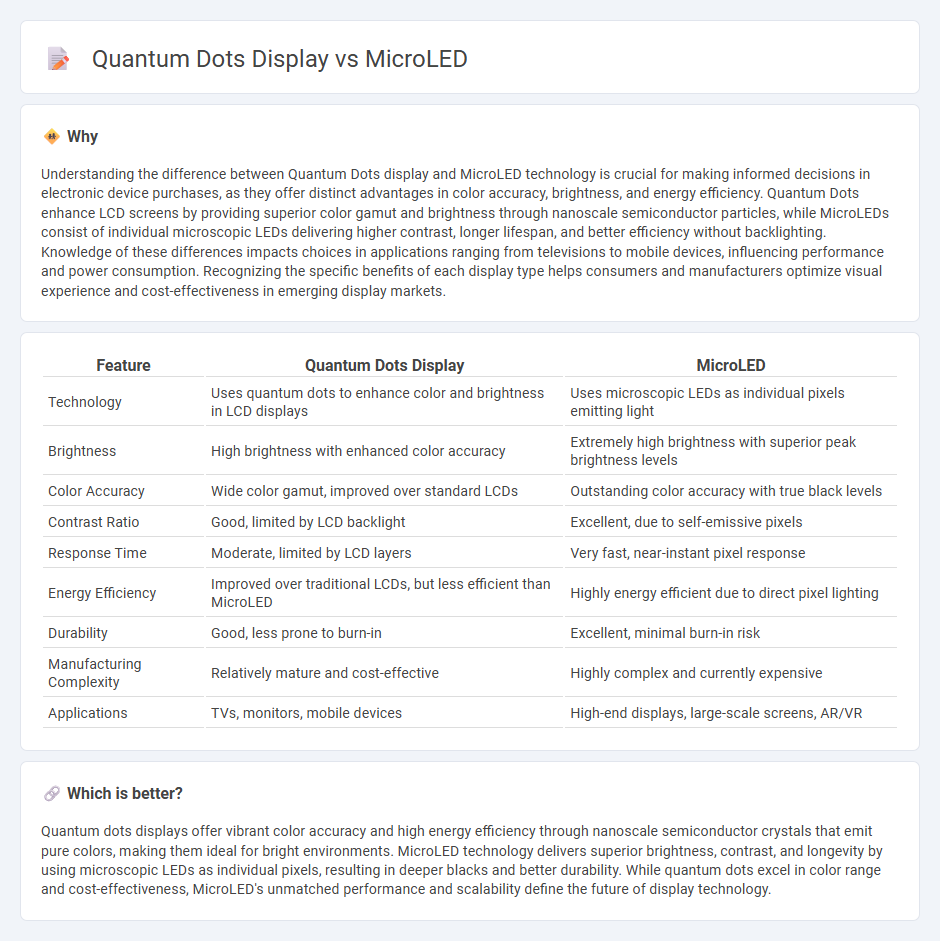
Quantum dots display technology utilizes semiconductor nanocrystals to produce vibrant colors with high brightness and energy efficiency, enhancing visual performance in modern screens. MicroLED displays consist of microscopic LEDs that offer superior contrast, faster response times, and longer lifespan compared to traditional OLEDs and LCDs. Discover the key differences and advancements shaping the future of display technology.
Why it is important
Understanding the difference between Quantum Dots display and MicroLED technology is crucial for making informed decisions in electronic device purchases, as they offer distinct advantages in color accuracy, brightness, and energy efficiency. Quantum Dots enhance LCD screens by providing superior color gamut and brightness through nanoscale semiconductor particles, while MicroLEDs consist of individual microscopic LEDs delivering higher contrast, longer lifespan, and better efficiency without backlighting. Knowledge of these differences impacts choices in applications ranging from televisions to mobile devices, influencing performance and power consumption. Recognizing the specific benefits of each display type helps consumers and manufacturers optimize visual experience and cost-effectiveness in emerging display markets.
Comparison Table
| Feature | Quantum Dots Display | MicroLED |
|---|---|---|
| Technology | Uses quantum dots to enhance color and brightness in LCD displays | Uses microscopic LEDs as individual pixels emitting light |
| Brightness | High brightness with enhanced color accuracy | Extremely high brightness with superior peak brightness levels |
| Color Accuracy | Wide color gamut, improved over standard LCDs | Outstanding color accuracy with true black levels |
| Contrast Ratio | Good, limited by LCD backlight | Excellent, due to self-emissive pixels |
| Response Time | Moderate, limited by LCD layers | Very fast, near-instant pixel response |
| Energy Efficiency | Improved over traditional LCDs, but less efficient than MicroLED | Highly energy efficient due to direct pixel lighting |
| Durability | Good, less prone to burn-in | Excellent, minimal burn-in risk |
| Manufacturing Complexity | Relatively mature and cost-effective | Highly complex and currently expensive |
| Applications | TVs, monitors, mobile devices | High-end displays, large-scale screens, AR/VR |
Which is better?
Quantum dots displays offer vibrant color accuracy and high energy efficiency through nanoscale semiconductor crystals that emit pure colors, making them ideal for bright environments. MicroLED technology delivers superior brightness, contrast, and longevity by using microscopic LEDs as individual pixels, resulting in deeper blacks and better durability. While quantum dots excel in color range and cost-effectiveness, MicroLED's unmatched performance and scalability define the future of display technology.
Connection
Quantum dots display technology enhances MicroLED screens by improving color accuracy and brightness through nanoscale semiconductor particles that emit precise wavelengths of light. MicroLED displays benefit from quantum dots' ability to convert blue light into highly pure red and green, enabling wider color gamut and superior energy efficiency. This synergy results in next-generation displays with exceptional contrast, longer lifespan, and faster response times ideal for high-resolution applications.
Key Terms
Self-emissive pixels
MicroLED displays feature self-emissive pixels composed of microscopic inorganic LEDs that directly emit light, resulting in superior brightness, contrast, and energy efficiency compared to Quantum Dot displays, which rely on a backlight system with photoluminescent quantum dots enhancing color purity but lacking true self-emission. Quantum Dot displays typically fall under LCD technology, where the self-emissive capability is limited, affecting black levels and dynamic range. Explore further to understand the detailed performance metrics and cutting-edge applications of MicroLED versus Quantum Dot self-emissive display technologies.
Color purity
MicroLED displays offer superior color purity due to their self-emissive pixels, which emit precise wavelengths of light without the need for color filters, resulting in vibrant and accurate colors. Quantum dot displays enhance color purity by using semiconductor nanocrystals that convert light into pure, saturated colors, improving brightness and color gamut but relying on a backlight source. Explore the detailed differences in color performance and technology between MicroLED and Quantum dot displays to understand their impact on visual quality.
Energy efficiency
MicroLED displays offer superior energy efficiency due to their self-emissive technology, which reduces power consumption by individually controlling each pixel without the need for a backlight. Quantum dot displays, while more efficient than traditional LCDs, still rely on backlighting and consume more power in comparison to MicroLEDs. Explore further to understand how these technologies impact energy consumption and device performance.
Source and External Links
What is MicroLED - MicroLED is a display technology using tiny LEDs that directly emit light as individual pixels, offering higher efficiency, better image quality, flexibility, and durability compared to LCD and OLED displays.
What is a MicroLED? - Ansys - MicroLEDs are micrometer-sized LEDs made from compounds like InGaN that act as individual pixels in arrays, providing high contrast, faster response times, and greater energy efficiency than traditional LCDs and OLEDs, with ongoing research into cost-effective manufacturing.
Samsung's The Wall | MicroLED Displays - Samsung's MicroLED technology creates modular, scalable displays with pure blacks, wide color gamut, stunning picture quality, and flexible installation options, designed for superior visual experiences in large-scale digital signage and premium environments.
 dowidth.com
dowidth.com